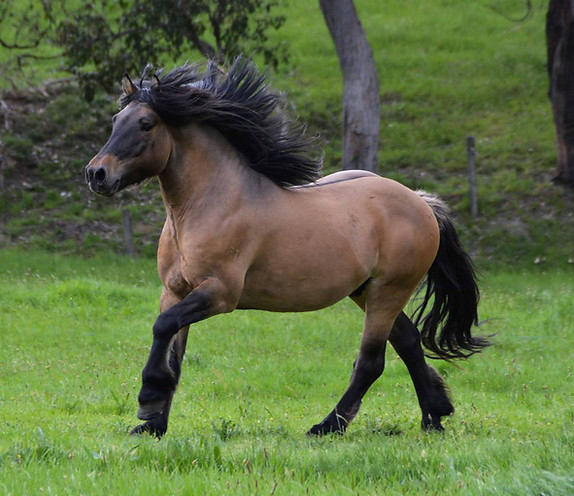
Highland Pony

One of the most versatile of British native breeds. It is hardy and of sound constitution, while the winter coat, consisting of a layer of strong, badger-like hair over a soft, dense undercoat, enables it to live out in all weathers.
They are good rides, and make excellent “family” ponies, many being natural jumpers. They are easily broken to harness and because of their docility, sure-footedness and native intelligence, are invaluable as pack ponies and for farm and forestry work.
The Highland Pony, ranging in height from 13 hands to 14.2 hands high (not exceeding this height), is one of the most versatile of British native breeds. It is hardy and of sound constitution, while the winter coat, consisting of a layer of strong, badger-like hair over a soft, dense undercoat, enables it to live out in all weathers. As the breed has a height range of 6 inches, obviously some of the smaller ponies will be of lighter type than the larger ones. All, however, should have the same assets of good bone and substance for their height, thus making them stronger, and up to more work and weight than most other ponies of similar size.
Highlands of all heights should be compact, with good fronts, shoulders, and withers and with well-developed quarters. They should move straight and freely and show true 'pony' character. They are good rides, and make excellent "family" ponies, many being natural jumpers. They are easily broken to harness and because of their docility, sure-footedness and native intelligence, are invaluable as pack ponies and for farm and forestry work. Highland Ponies also make good foundation stock for the breeding of high-class hunters and event horses, the transmission to their off-spring of much of their natural sagacity being here of inestimable value.
The Highland Pony Breed characteristics are as follows:
HEAD: Well carried; broad between alert and kindly eyes; short between eyes and muzzle; muzzle not pinched, nostrils wide.
NECK: Strong, not short; good arched top-line; throat clean and not fleshy.
SHOULDER: Well laid back, withers pronounced.
BODY: Compact; back with slight natural curve; chest deep, ribs well-sprung
and carried well back.
QUARTERS: Powerful; strong, well-developed thigh and second thigh.
LEGS: Flat, hard bone, forearm strong, knee broad, short cannon, pasterns oblique, not too short; well shaped, hard, dark hooves. Forearm placed well under the weight of the body, hocks clean, flat and closely set. Feathers silky, and not over-heavy, ending in a prominent tuft at the fetlock.
MANE AND TAIL: Hair should be long, silky and flowing, not coarse. Tail set fairly high and carried gaily.
COLOURS: Various shades of dun: mouse, yellow, golden, grey, cream, fox, etc. Also grey, brown, black and occasionally bay and liver chestnut with silver mane and tail. Most ponies carry the dorsal eel-stripe and many have zebra markings on the inside of the forelegs. Apart from a small star, white markings (blazes, socks etc.) are disliked and discouraged.
Stallions with white markings other than a small star are not eligible for registration.
A small star is defined as no greater than 2.5cm in diameter.
Information courtesy of the Australian Pony Stud Book Society Inc.
